2023 NHL Draft Rankings: Connor Bedard tops midseason top 70
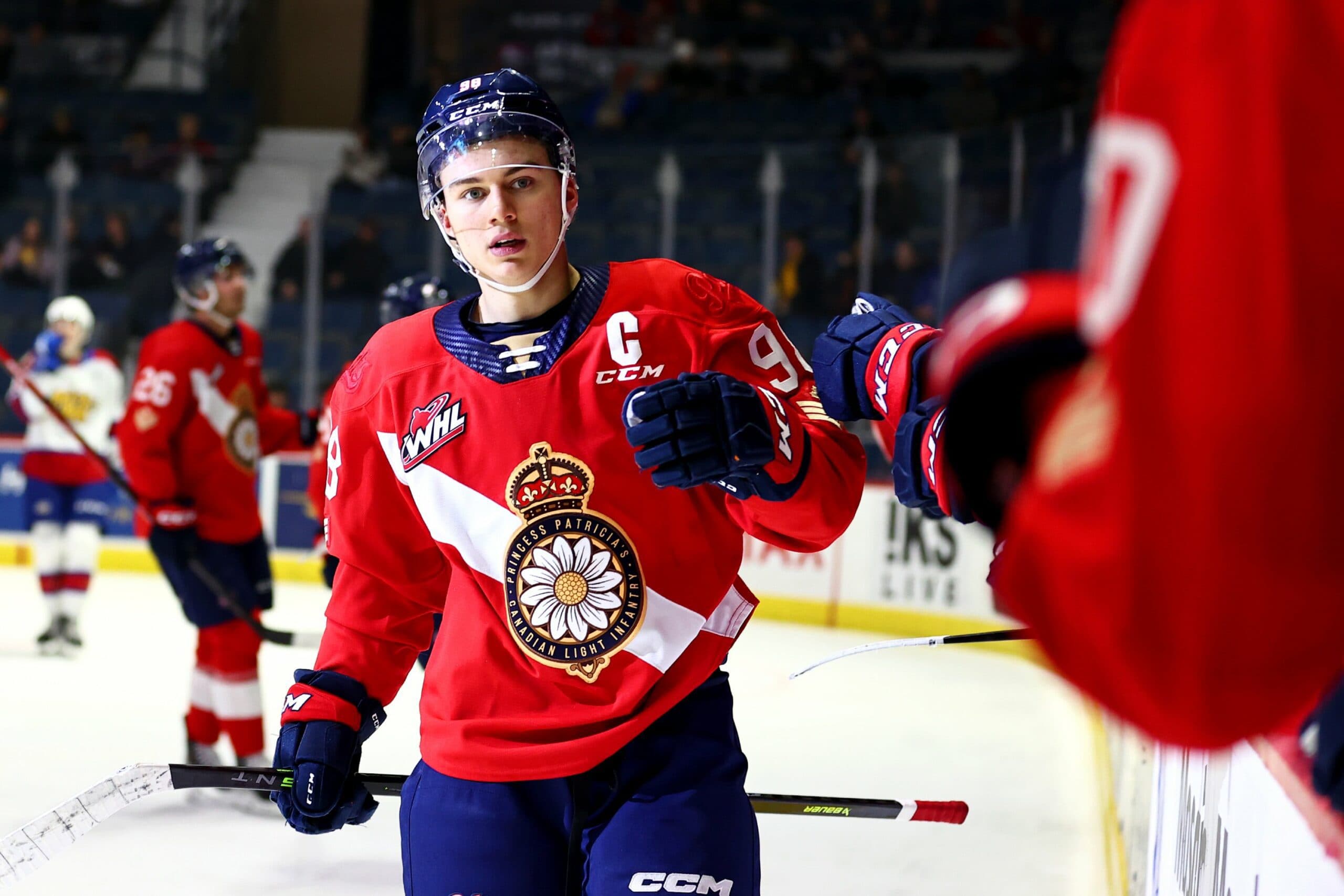

Think you know sports? PointsBet Canada is live in Ontario!
_____
Every draft earns exceptional hype. But, truly, the 2023 NHL Draft deserves it.
And it starts at the top. Connor Bedard helped cement his status at the World Junior Championship as the best prospect in years, with many scouts comparing his body of work those of Connor McDavid, Auston Matthews and Patrick Kane. And then there’s a whole host of others that, in many other draft classes, would have a strong case to go No. 1.
When I first looked at the 2023 draft class back in October, we didn’t have much to work with, sample size-wise. We only had a few weeks of actual game action, and many leagues had just a couple of games to work off of. We’re past the halfway point now, with various high-level showcase events done and dusted: the Hlinka Gretzky Cup, the U-18 Five Nations, the world juniors and Biosteel All-American Game, among the more notable events. So, for the most part, we’ve got a good grasp on the prospect world, with the CHL’s Top Prospect Game and U-18 World Championship among the next big events on the scouting calendar.
Compared to most years, I think the first round will be as deep as ever. Bedard, Adam Fantilli, Leo Carlsson and Matvei Michkov are definitely among the top of the class, with a host of other highly talented players at every position forcing themselves into the conversation. Bedard is the real prize, but the teams that lose out on the lottery aren’t going to come out empty-handed.
So, let’s take a look at my latest top 70 NHL Draft rankings at the halfway point of the 2022-23 season:
1. Connor Bedard, C (Regina, WHL)
The best prospect in years, no doubt, and he showed that with one of the best World Juniors of all time. With an elite shot (and I don’t like using the word elite to describe anyone), excellent heads-up vision and a level of tenacity you’re not used to seeing from a smaller prospect, Bedard packs a strong punch. His wrist shot is dangerous, accurate and deceptive, allowing him to score at will. His historic run at the World Junior Championship proved he’s too good for his own age group and should have no issue adjusting to the next level. It’s worth noting that while Bedard mainly plays center, he spent the past two WJCs on the wing.
2. Adam Fantilli, C (University of Michigan, NCAA)
Fantilli would have a robust case to become the first overall pick in most other years. Prior to joining Canada’s world junior team, Fantilli was near the top of the NCAA scoring race and even led it for the first two months. From a first-year draft-eligible standpoint, Fantilli has had one of the best seasons since Jack Eichel in 2014-15. He has good size, can be so tough to take off the puck at speed and doesn’t overextend himself trying to be an everything player at all times. He had a quiet WJC, but Bedard set the bar too high. Don’t be worried.
3. Matvei Michkov, C (Sochi, KHL)
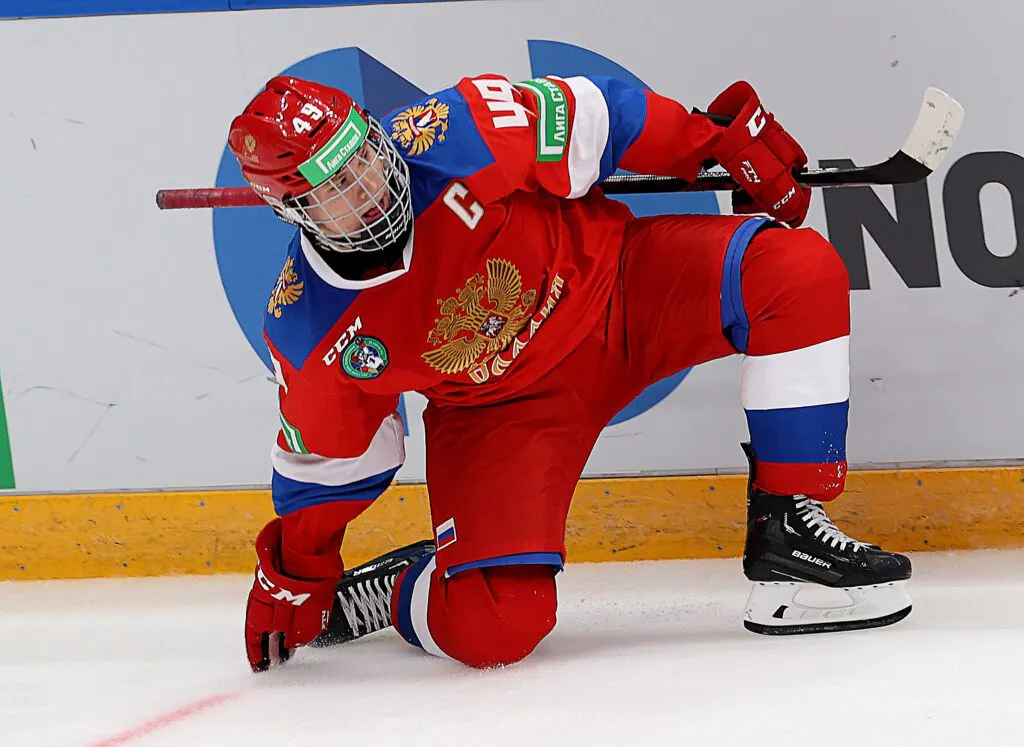
Perhaps the most controversial figure in the draft, and not for his on-ice talent, is Michkov. He’s signed to a KHL deal until 2026, which alone hurts his stock. But an early season injury resulted in a later start to the season, and after going pointless in three games with SKA St. Petersburg, he was sent down to the VHL – the Russian equivalent of the AHL. He scored at nearly a point-per-game pace and was clearly too good for second-tier action and was loaned out to HK Sochi to finish off the season. He scored in his second game with Sochi and had four goals in his first eight games, instantly finding his groove on the worst team in the KHL by far. It wasn’t that long ago that Michkov was deeply considered the biggest challenger to Bedard to go first overall, and I still believe the skilled forward will be an incredible NHLer. We’ll just have to wait a while to witness him realize that potential. Leo Carlsson has made an incredible push for third, but I’m holding strong with Michkov.
4. Leo Carlsson, C (Orebro, SHL)
One of the biggest risers inside the top 10 this year, Carlsson has had a season to remember. He’s putting around at just over half a point-per-game in the SHL, which is rare for any U-18 player. He then had six points at the world juniors while playing a middle-six role, which, in most years, would be considered highly impressive by a draft prospect. Carlsson is big at 6-foot-3, allowing him to hold his own physically against men. He’s extra dangerous around the net, too. Here’s a deeper look at what scouts have to say about Carlsson’s game.
5. Zachary Benson, C/LW (Winnipeg, WHL)
Benson has played with quality players throughout his time in Winnipeg, but don’t get it mixed up: he’s the one creating much of the damage. Only Bedard has more points over the past three years among U-18 WHLers, and Benson has played at over a point per game throughout his entire tenure. He plays at a high pace with incredible straight-line speed, a high compete level and handles the puck as well as anyone in this age group. It’s hard not to be impressed when watching Benson with the puck on his stick, and he’s easily one of the smartest players in the draft.
6. Andrew Cristall, LW (Kelowna, WHL)
If you follow prospects closely online, Cristall has no shortage of fanatics. And there’s a good reason – he’s on pace for 115 points in his second full season in the WHL. Easily one of the most electric forwards in the class, Cristall is a confident shooter, shown by how he’s willing to get the puck off from just about anywhere, even if that means catching a goalie off guard with an off-angle release. Defensively, he’s not there yet, but he’s equally good as a shooter and a passer and should have no issue generating offense in the NHL one day.
7. Will Smith, C (USNTDP)
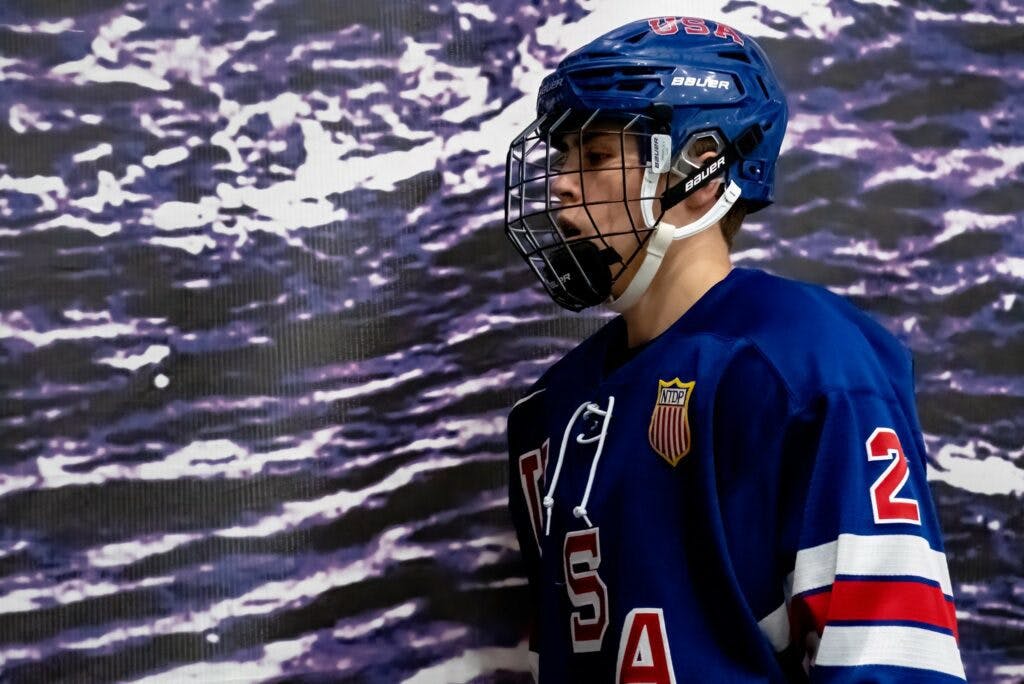
While there isn’t anything that really stands out about Smith’s game, he is definitely one of the more well-rounded forwards in the top 10. He’s deceptive, handles the puck well on the rush and you can count on a full effort every time he hits the ice. Smith drives a lot of the play on his line and his confidence to make quick dekes is sky-high.
8. Eduard Sale, RW (Kometa Brno, Czechia)
Sale spent a game as Czechia’s 13th forward at the World Junior Championship but eventually became a key piece of the top line during the medal round. Internationally, Sale has been excellent this season, and he has spent the rest of the campaign with Brno in the top Czech league. He has proven he can handle playing against men, Sale is most effective with the puck on his stick, and it helps that he’s a fantastic puckhandler and a tremendous skater. I feel like there are points where he gives up a bit too quickly on plays, but the numbers against his age group show why he’s one of the most gifted offensive talents in the draft.
9. Oliver Moore, C (USNTDP)
Many scouts believe Moore has the highest ceiling among USNTDP kids, and I don’t doubt it. Moore is so quick, brings a high work ethic to every shift and attacks as hard as anyone. His game is all about speed and energy, and he generates a ton of offense on USA’s second line. Moore especially stood out on his own at the All-American Game earlier this month, playing away from much of the USNTDP’s top talent and scoring the game’s first goal. That’s just a single game, but scouts liked how much he did without the security blanket he’s used to.
10. Axel Sandin Pellikka, RHD (Skelleftea, SHL)
Sandin Pellikka turned heads as the top first-year draft-eligible defensive prospect at the WJC. He’s an offensive-minded blueliner who isn’t afraid to rush the puck down the ice and engage in the play. He was quiet on the scoresheet at the WJC, but he played over 20 minutes four times, including all three playoff games. Sandin Pellikka can hold his own against older competition and his confidence has definitely grown over the past few months. He loves the puck on his stick, and he might be the best overall skating blueliner in the draft. His defensive zone play lacks at points, but the right coaching can help fill in the gaps.
11. Dalibor Dvorsky, C (AIK, HockeyAllsvenskan)
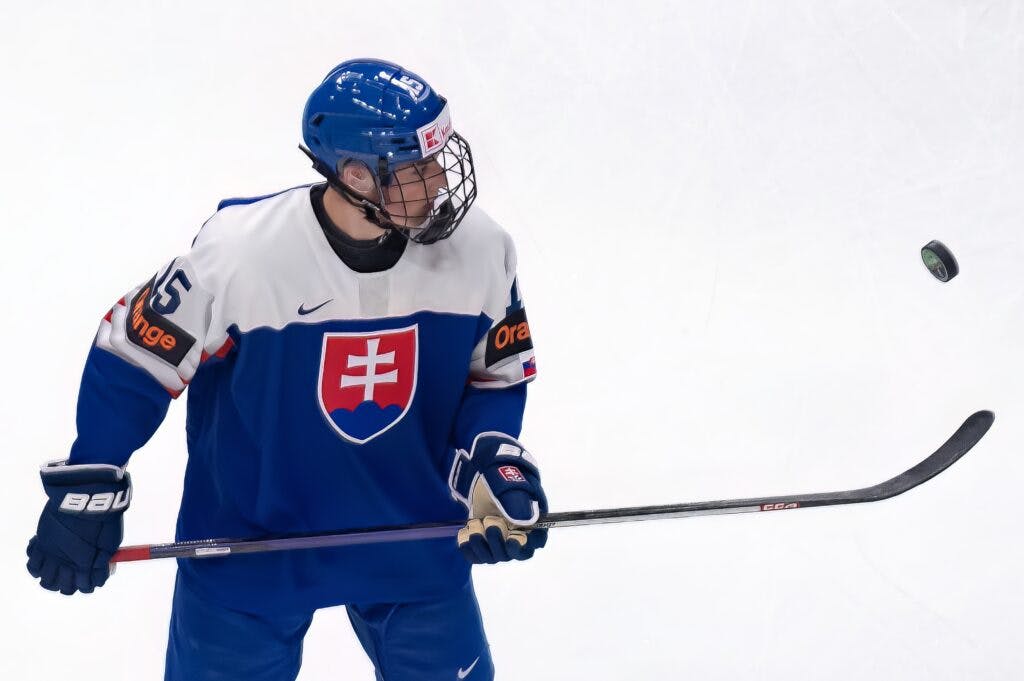
Dvorsky made a name for himself after tearing apart the 2021 Hlinka Gretzky Cup when he led Slovakia to silver with eight goals and 12 points in five games. He had a pair of quiet World Junior Championship appearances and has had a so-so run with AIK over the past two years. Still, the raw talent is there. Dvorsky has one of the quickest releases and, when fully engaged, he’s smart enough to get creative without turning over the puck. There’s just too often where it feels like he’s floating around and logging ice time instead of being fully engaged, which is why he went from an early projected top-five pick to further down. But in terms of pure skill, I think he’ll be fine.
12. Riley Heidt, C (Prince George, WHL)
I have Heidt higher than the consensus, but he’s also one of my favorite prospects in the game. As a playmaking center, I love him. He has great vision, a solid understanding of when to hold on an extra few seconds and when to force a pass, and you can always rely on him to support his defensemen. Heidt might also be one of the best overall skaters from the draft class. Heidt isn’t very physical and can follow the play more than he should at 5-on-5, but he’s had to do a lot of heavy lifting in Prince George the past two years and has handled it well. I think he’ll be an impactful NHLer.
13. Ryan Leonard, RW (USNTDP)
A high-end sniper, Leonard owns a shot that combines a nice mix of speed and accuracy, allowing him to get it off quickly without hesitation. When given room on the power play, he can let his shot fly and hold his own around the net in physical situations. The younger brother of Nashville Predators prospect John Leonard has pro pedigree written all over him and should be a solid secondary scorer in the NHL.
14. Mikhail Gulyayev, LHD (Omsk, KHL)
Gulyayev has split the year almost equally between the KHL, VHL and MHL and has shown glimmers of promise throughout. The agile, offensive defender does an excellent job of shielding himself from attackers when controlling the puck and sends the puck down the ice for a scoring chance from his own zone. But like many high-octane two-way forwards, his defensive play is prone to the odd hiccup, so he needs to iron that out. And, whether it’s fair or not, teams might not be willing to commit high in the draft on a player hanging out in Russia.
15. Otto Stenberg, C (Frolunda, Sweden U-20)
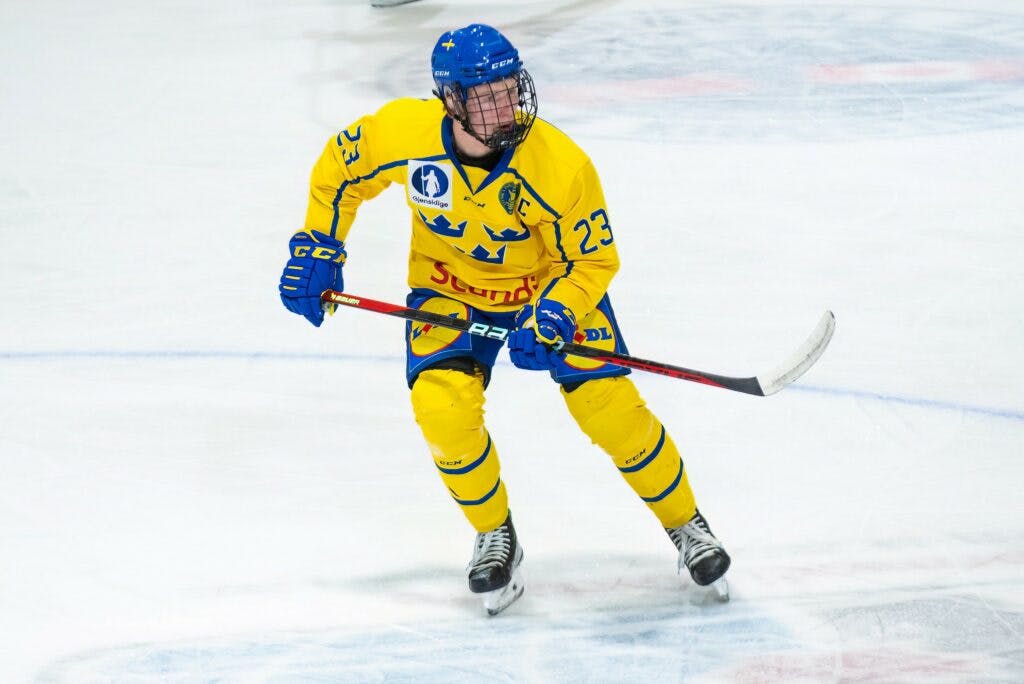
When Stenberg gets possession of the puck, you notice. He’s a skilled forward with a penchant for highlight-reel goals and plays fast and dangerously. He’s got experience at center and the wing and has been successful at both, which gives him some extra versatility. He started the year off with a great Hlinka-Gretzky Cup and has continued it with excellent play in the Swedish U-18 league. Stenberg also has some SHL experience, and he’s had some good showings there.
16. David Reinbacher, D (EHC Kloten, NL)
It was easy to overlook Reinbacher given Austria’s poor play, but it’s clear how important he was. They got blasted by all the big Group A heavyweights, but Reinbacher held his own the best he could. The biggest indication of how much he mattered, though, came during the relegation round. The well-rounded blueliner had a couple of good showings with EHC Kloten after returning to Switzerland, especially in his zone. Reinbacher is playing with a high level of confidence right now, and it wouldn’t be surprising to see him become the first defender drafted.
17. Brayden Yager, C (Moose Jaw, WHL)
The WHL has a ton of quality draft prospects, and while Yager may have fallen compared to where he was a year ago, he’s still an exceptional talent. He’s on pace for just over 80 points and when he’s on his game, he has the ability to take over and make everyone look much inferior. The issue? There are too many off nights and off shifts that concern scouts. If he can wrangle in his consistency, Yager has the potential to be one of the most dynamic, dangerous forwards in this class, and one with real value potential.
18. Ethan Gauthier, RW (Sherbrooke, QMJHL)
After an incredible Hlinka Gretzky Cup performance that saw him score six goals in five games, Gauthier hasn’t exactly lit up the QMJHL like I was hoping. Early on, it was exciting watching a mid-sized forward drive the play like he did and, despite not having a ton of muscle to work with, he handled any physical challenge sent his way with ease. But his game can be almost too simple at times and easy to predict for defenders, and when he isn’t driving plays, he can be a little less noticeable. Still, we’re talking about a player that’s on pace for around 80 points, and I think he brings enough tools to become a solid NHLer. I feel like something is missing offensively, and he’s fully capable of making it happen if he can find an extra gear.
19. Colby Barlow, LW (Owen Sound, OHL)
Few major junior players can convert like Barlow with the puck on his stick. He’s a two-time 30-goal scorer already and should hit the 50-goal mark later this season. Barlow has produced everywhere he has played in his career thanks to a release that very few can achieve at this age. You’re never going to criticize him for how hard he competes. One of the biggest knocks is his underwhelming playmaking decisions, but if Barlow cracks the NHL, it’s for his ability to put pucks in the net, anyways.
20. Nate Danielson, C (Brandon, WHL)
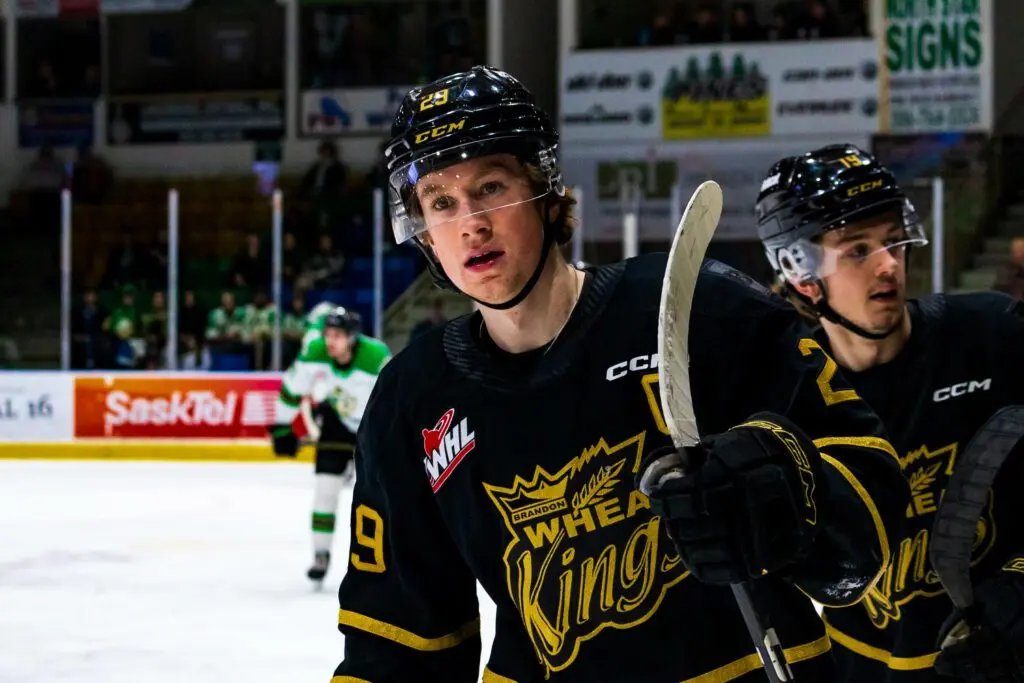
The Brandon Wheat Kings captain is on pace to hit 90 points as a sophomore, so we know the offense is there. His biggest strength from a technical standpoint is how he reads pressure and he’s no slouch as a backchecker, either. He’s not aggressive enough for my liking and I feel like he falls apart in physical matchups but he’s got enough raw talent that should translate well to the pro game.
21. Gavin Brindley, RW (University of Michigan, NCAA)
Brindley might not have the same numbers as his buddy Fantilli, but Brindley has been a must-watch prospect this season. I’m not too worried about his lack of production. I’m more impressed with how he thinks the game and how he uses it to adapt to whatever situations are thrown at him. Brindley plays at a high tempo, forcing turnovers and finding his teammates quickly. Brindley is a confident puck-handler, and while his shot lacks strength and he stands just 5-foot-9, I think there’s enough raw offensive talent for Brindley to become a decent middle-six forward with speed and creativity.
22. Calum Ritchie, C (Oshawa, OHL)
Once seen as a flashy forward with high offensive potential, Ritchie has played at under a point-per-game rate this year in Oshawa, catching everyone by surprise. He’s a reliable two-way forward that you can count on from a consistency standpoint, but he feels too… safe. I’d like to see him return to taking risks and getting more creative as we’ve seen in the past.
23. Samuel Honzek, C (Vancouver, WHL)
Honzek missed most of the World Junior Championship with a calf injury and will be out for at least another month. It’s a big blow for a forward who went over to the WHL and put the league on notice, recording four multi-point efforts in the two weeks leading up to tourney training camp. Honzek is big at 6-foot-4 but he plays like a much smaller player with good speed and skill. He’s a well-rounded, dangerous playmaker, and has a solid shot, to boot. Honzek is easily one of the bigger movers and, once he returns from injury, it’ll be interesting to see how he closes out the season.
24. Quentin Musty, LW (Sudbury, OHL)
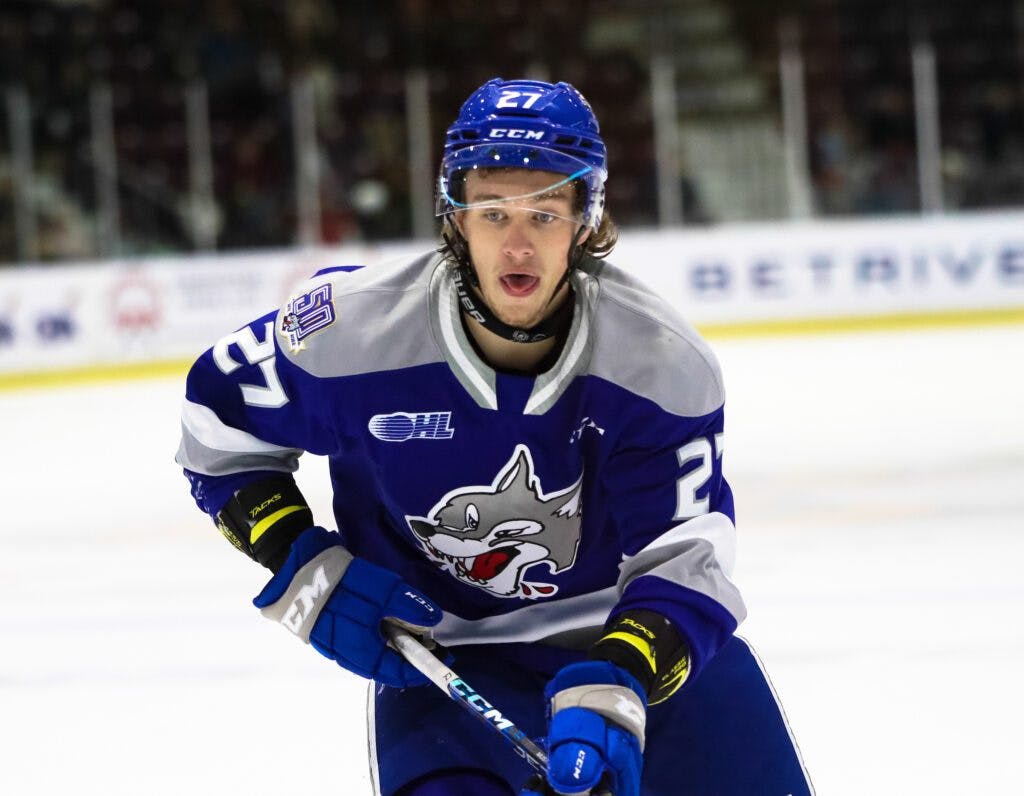
Scouts are split on Musty right now, but I’m a fan. Musty is thinking offense all the time and his compete level is near the top of the class. It bothers him when he gets stopped on a chance and he tries even harder the next time. Musty has a good release, and skates well enough, but I’d like to see him use his strength more to his advantage to dominate shifts like he used to at the U-16 level.
25. Lukas Dragicevic, D (Tri-City, WHL)
A big defender, there are too many games where Dragicevic looks completely disinterested in actually defending in his own zone. That’s something coaches can work with him when he no longer taking advantage of the extra space junior hockey offers. The upside here, though, is tremendous. He has a great shot from the point, likes to pinch in whenever he can and will do whatever it takes to keep the puck from crossing over into the neutral zone behind him. He has good offensive instincts and I think he’ll continue to move forward defensively.
26. Dmitri Simashev, D (Lokomotiv Yaroslavl, KHL)
Simashev is this year’s big, crushing blueliner. The 6-foot-4, 201-pound defenseman has bounced around between the KHL and MHL, and he’s especially physically dominant in MHL play. He’s excellent in his zone and moves well for a bigger blueliner. His lack of offensive upside knocks him down a few pegs but he’ll be one son-of-a-you-know-what to go up against.
27. Matthew Wood, RW (University of Connecticut, NCAA)
A high-end scorer with a big frame and good patience, Wood’s game is about power. Not necessarily physically, but his shot scares goaltenders and he’s strong enough to outmuscle most competition, even if he isn’t out there laying hits. The biggest knock against him is his poor top speed. Skating coaches can fix that, and Wood will become much more dangerous if it improves.
28. Charlie Stramel, C (University of Wisconsin, NCAA)
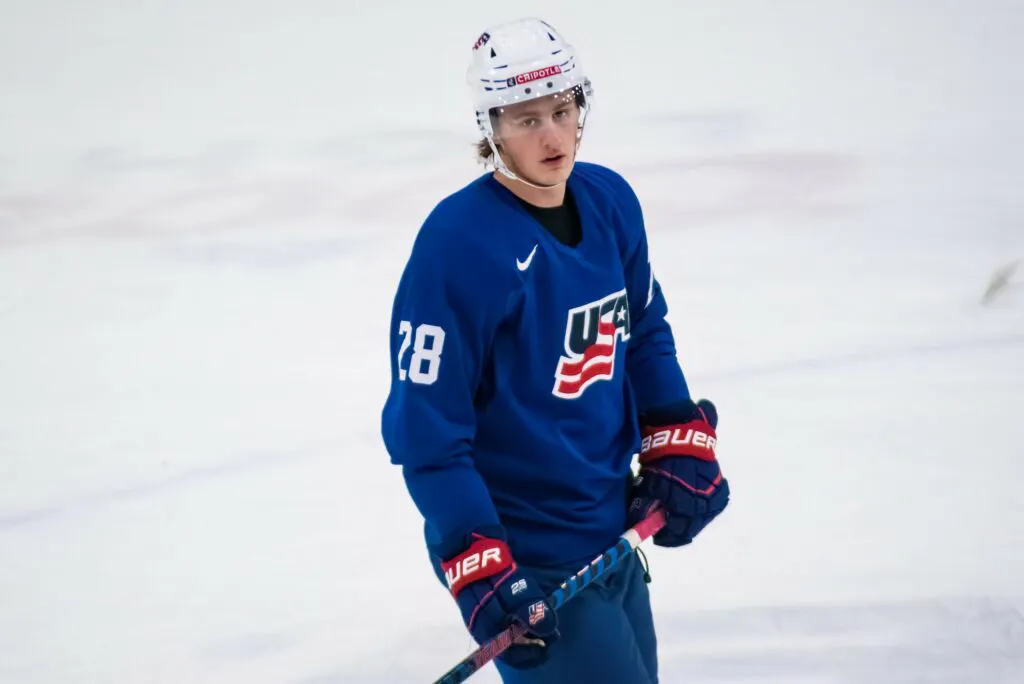
Sometimes, I feel like Stramel is a ticking time bomb. He’s physical and loves to show it every chance he can. Other times, he’s pulling off moves that you can’t help but fall in love with. The challenge moving forward for the 6-foot-3, 216-pound center is to show he’s more than just a big body, but it might take a while for him to realize his potential fully. The upside in picking Stramel is significant if you’ve got a solid prospect pool and are willing to be patient.
29. Michael Hrabal, G (Omaha, USHL)
Sometimes, you have to look beyond the stats. Hrabal’s numbers with the USHL’s Omaha Lancers are nothing special, but scouts love his raw potential. He’s 6-foot-6, faces a significant number of shots a night, tracks the puck well, has good athleticism and covers the net down low well. One of the biggest knocks, style-wise, is how he can be caught going down too early often, but he’s an imposing figure that’s tough to beat on a given night.
30. Cameron Allen, D (Guelph, OHL)
I was much higher on Allen to start the season, but I still think he has a promising future. The best way to describe Allen is “well-rounded.” Even when he’s on the losing end, he shows good decision-making, can skate well and does a solid job in his own zone. He isn’t that big, but he can handle himself physically, even if he’s not the one initiating hits. I’d like to see him make better decisions while under pressure or late in a game, but there’s a solid base to work with here.
31. William Whitelaw, C (Youngstown, USHL)
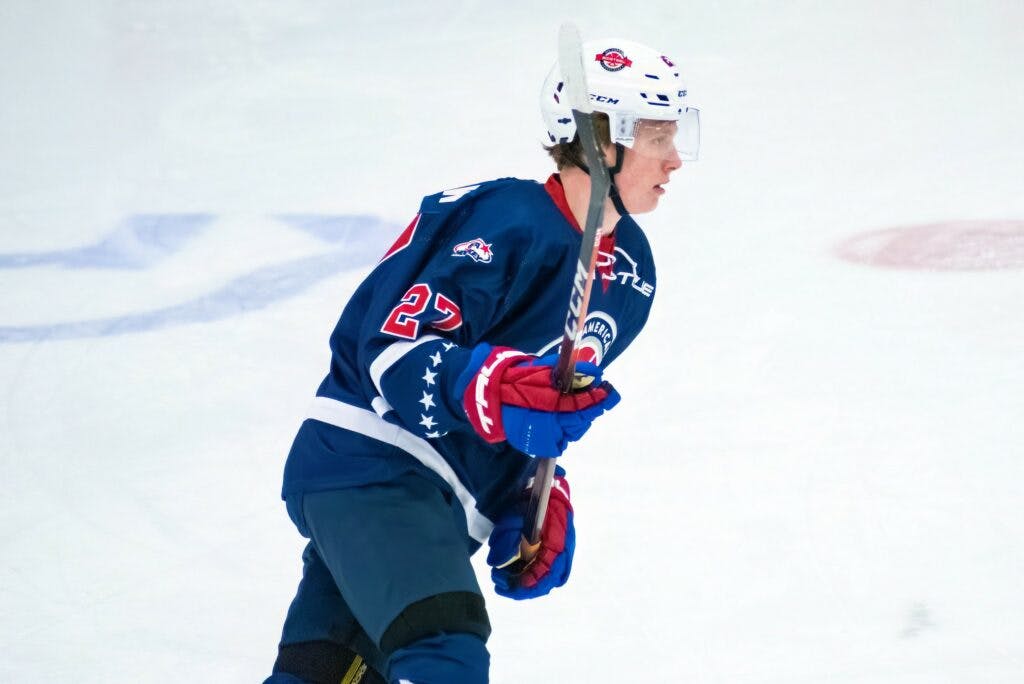
Whitelaw’s game can be really hit or miss, and his lack of size doesn’t help. But when he’s on his game, he’s REALLY on his game. He’s producing at just over a 50-point pace which is nothing to write home about, but he’s an impressive goal scorer that does a lot of his damage in close and can really get under your skin. He has a pesty nature to him at points, and when Youngstown wins big, Whitelaw is usually one of the biggest reasons why.
32. Adam Gajan, G (Green Bay, USHL)
A bold pick, maybe? Scouts I talked to at the World Junior Championship fell in love with Gajan, who many believed to be a diamond in the rough. Gajan went undrafted out of the Slovak league last year but made some noise in the NAHL and USHL before joining Slovakia as the team’s third goalie to begin. Before too long, he was the No. 1 and giving fits to teams like Canada and USA. Gajan doesn’t have a major sample size, which probably knocks him down a bit, but he has great size, excellent athleticism and seems to only get better with more viewings.
33. Noah Dower Nilsson, C (Frolunda, Sweden U-20)
The younger brother of Detroit Red Wings prospect Liam Dower Nilsson, Noah had an impressive first half of the season. While skating is definitely not his strong suit, he made up for it with a fantastic release, a solid frame and, most importantly, confidence with and without the puck. He hasn’t played since the World Junior A Challenge, where he was injured early on. But the sample size in the Swedish U-20 league and internationally is impressive.
34. Daniil But, LW (Yaroslavl, MHL)
But has seen some time in the KHL, but has mostly split the season between Loko Yaroslavl and Loko-76 in the MHL this season. He has 26 points in 25 games, with his 1.04 points-per-game average placing him in third among U-18 players with at least 20 games played. At 6-foot-5, But moves better than most kids his age and it often looks effortless. He has a broad skillset and can catch you off guard with some of the clean, creative plays he makes. A big forward that can skate well? Scouts like him.
35. Aram Minnetian, D (USNTDP)
This might be higher than most people have Minnetian, but I have high hopes for him. I feel like he doesn’t get enough attention for the way he commands the puck from the blueline. He’s not a big kid, and there are not a ton of standout qualities, but I think he has enough to build upon to become a decent second-pairing option that can quarterback a power play. His play since the U-18 Five Nations in November has been especially impressive, and I’m excited to see what type of role he makes for himself at Boston College.
36. Jayden Perron, RW (Chicago, USHL)
From a pure skill perspective, it’s hard to deny Perron’s skill. He’s a point-per-game player with the USHL’s Chicago Steel, a team with no shortage of high-profile prospects for the next few drafts. He’s an excellent skater that attacks every shift at speed and scouts consider him as one of the most effective passers in the draft class. But they also point to the elephant in the room: he’s 5-foot-8. I’m not sure his shot and pure offensive skill are enough to offset the size concerns yet. The big test will be seeing how he adjusts to the much tighter NCAA next season.
37. Hunter Brzustewicz, RHD (Kitchener, OHL)
I know I wasn’t the only one who felt disappointed about the end of Brzustewicz’s USNTDP career. But now, I feel like he’s much more polished and comfortable with Kitchener. He loves the puck on his stick and looks comfortable taking the puck end to end. That can get him into trouble more than you’d like to see, but I like that he’s willing to take risks and challenge himself against quality opponents. He’s a solid modern-day defenseman that can fit a role in the NHL one day.
38. Alex Ciernik, LW (Sodertalje, Sweden U-20)
The son of former NHLer Ivan Ciernik, Alex Ciernik has looked excellent internationally and has put up some solid numbers at the Swedish U-20 level. But, most impressively, he has also had stints in the second-tier Swedish pro league, and he scored in two of his first three games with Vasterviks this month. He looks confident every time he gets a hold of the puck, and he doesn’t like to skate long without it.
39. Oliver Bonk, D (London, OHL)
Yes, his Dad is Radek. But, given they don’t play the same position, there’s no real comparison. The younger Bonk is having an excellent rookie season with the Knights after spending most of the year in the GOJHL, showing promise as a puck-rushing defender that can man the power play and jump in on the rush. I wasn’t overly high on him earlier because I wasn’t sure his ceiling was that high, but I like the way he thinks the game under pressure, and there might be something there.
40. Gabe Perreault, LW (USNTDP)
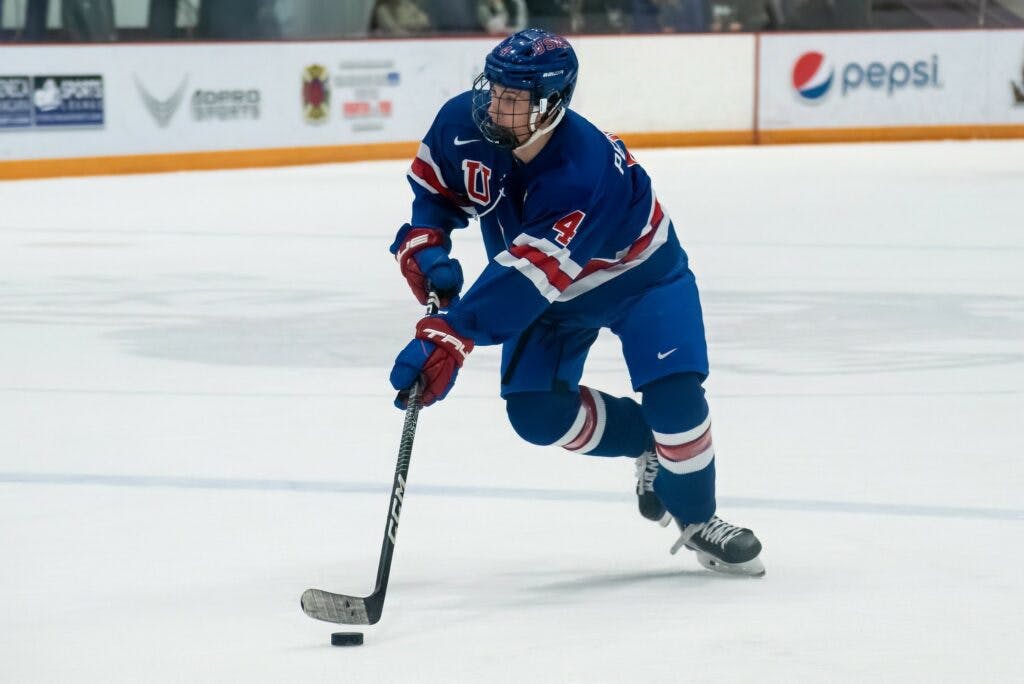
The biggest knock against Perreault is that many scouts feel like he’s carried by his linemates, Ryan Leonard and Will Smith. I don’t think that’s totally fair. You don’t get a team-leading 33 goals and 69 points in 36 games by just standing around and banging in rebounds. He’s a dynamic scoring forward who handles the puck as well as anyone, and he tends to know where he has to be. That being said, Perreault isn’t quick and can look lost in his own zone. For as talented as he is, Perreault needs to be in a scoring role to succeed at the next level. And in the right situation, he can do that. I think he’ll have a solid career as a middle-six winger. But some scouts feel a bit concerned over his true potential.
41. Danny Nelson, LW (USNTDP)
42. Koehn Ziemmer, RW (Prince George, WHL)
43. Etienne Morin, D (Moncton, QMJHL)
44. Jesse Nurmi, C (KooKoo, Liiga)
45. Luca Cagoni, D (Portland, WHL)
46. Caden Price, D (Kelowna, WHL)
47. Tom Willander, D (Rogle, Sweden U-20)
48. Andrew Strathmann, D (Youngstown, USHL)
49. Carson Bjarnason, G (Brandon, WHL)
50. Luca Pinelli, C (Ottawa, OHL)
51. Timur Mukhanov, C (Omskie, MHL)
52. Denver Barkey, C (London, OHL)
53. Bradly Nadeau, C (Penticton, BCHL)
54. Trey Augustine, G (USNTDP)
55. Beau Akey, D (Barrie, OHL)
56. Lenni Hämeenaho, LW (Assat, Liiga)
57. Kasper Halttunen, RW (HIFK, Liiga)
58. Alexander Rykov, RW (Chelyabinsk, VHL)
59. Kalan Lind, C (Red Deer, WHL)
60. Jacob Fowler, G (Youngstown, USHL)
61. Tanner Adams, RW (Tri-City, USHL)
62. Theo Lindstein, D (Brynas, SHL)
63. Aydar Suniev, LW (Penticton, BCHL)
64. Carson Rehkopf, C (Kitchener, OHL)
65. Felix Nilsson, C (Rogle, Sweden U-20)
66. Tanner Moldenyk, D (Saskatoon, WHL)
67. Gracyn Sawchyn, C (Seattle, WHL),
68. Mathieu Cataford, RW (Halifax, QMJHL)
69. Matthew Mania, D (Sudbury, OHL)
70. Tuomas Uronen, RW (HIFK, Finland U-20)
Recently by Steven Ellis
More from Steven Ellis
- Penguins’ goaltending depth has an opportunity to flourish following Tristan Jarry trade
- 2026 World Juniors Preview: Germany just hopes to stick around
- USHL’s Madison Capitols to host “Birds Aren’t Real” night, rebrand to Surveillance Swans
- Former NHL coach Michel Therrien to lead Canada’s 2025 Spengler Cup team
- Pete DeBoer not ruling out NHL coaching job if made available before Olympics